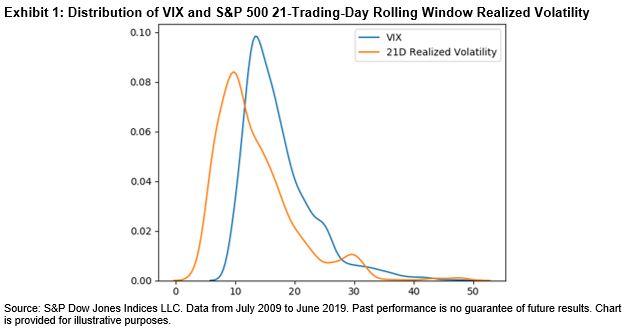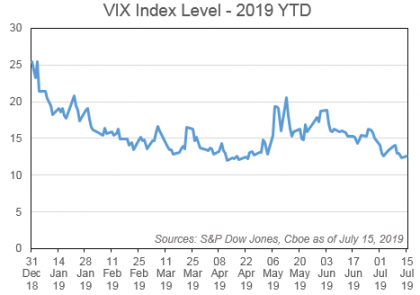While nearly everyone in the Canadian investment community has heard of the S&P/TSX Composite, few are aware of the key methodological intricacies that distinguish it from other broad market Canadian equity benchmarks.
The most notable distinction is that the S&P/TSX Composite is designed specifically for Canadians (as are all S&P/TSX Indices), while many other Canadian equity indices, such as the FTSE Canada All Cap Index, are simply country slices of global benchmarks and, therefore, take the perspective of foreign investors. Now, why does this matter you might ask? Well, Canada has foreign ownership limits that affect several industries, such as telecommunications, broadcasting, transportation, and real estate. So, whether or not these limits are accounted for in the index is significant.
As an example, Bell Canada (BCE)—the largest Canadian telecommunications company—was the 10th largest company in the S&P/TSX Composite, with a weight of 2.3%, as of June 28, 2019 (see Exhibit 1). However, foreign investors are restricted from owning more than one-third of BCE under Canada’s Telecommunications Act. As a result, BCE’s weight in the FTSE Canada All Cap Index is reduced by two-thirds from its natural market-cap weighting to roughly 0.75%.

Real estate investment trusts are also subject to a 49% ownership limit, which results in the weight of the Real Estate sector being reduced in the FTSE index relative to the S&P/TSX Composite. Ultimately, the differing treatments of foreign ownership limits is a key driver of the FTSE Canada All Cap Index’s higher concentration in Financials and lower exposure to other sectors such as Communication Services and Real Estate, as illustrated in Exhibit 2.

Differing definitions of what constitutes a Canadian company for index assignment purposes are also important to consider. For example, Shopify—the Canadian e-commerce company—was added to the S&P/TSX Composite in March 2017. However, FTSE Russell classified Shopify as a U.S. company until January 2019, which prevented it from being included in the FTSE Canada All Cap Index until earlier this year.
The S&P/TSX Indices also include companies structured as limited partnerships (LPs), whereas FTSE Russell’s global equity index methodology excludes them. Because of this, several Brookfield Partnerships that own and operate infrastructure, real estate, and renewable energy assets are excluded from the FTSE Canada All Cap Index. These companies represent a weight of about 1.5% in the S&P/TSX Composite.
Finally, the S&P/TSX Composite is a broader representation of the Canadian equity market relative to the FTSE Canada All Cap Index. As of June 28, 2019, the S&P/TSX Composite included 239 constituents, representing a total index market cap of nearly CAD 2.3 trillion, while the FTSE Canada All Cap Index included 205 components and a 6% smaller aggregate index market cap of CAD 2.15 trillion. This disparity is partially driven by the inclusion of LPs, but it is largely due to the relatively more inclusive size and liquidity requirements of the S&P/TSX Composite.

While the returns of the two indices have historically tracked fairly closely, the methodology differences discussed have contributed to meaningful performance differences over time. As depicted in Exhibit 4, the 3.87% total return of the S&P/TSX Composite was nearly 1% greater than the FTSE Canada All Cap Index over the trailing 12-month period. Over the past 10 years, the S&P/TSX Composite has outperformed by 42 bps per year with slightly lower volatility.

In summary, it is important to look under the hood and understand the design features of seemingly similar benchmarks. Because of its comprehensive nature and Canadian-centric design features, the S&P/TSX Composite may more fully and accurately reflect the investment opportunity set available to Canadian investors in comparison to other market indices.
As a final note, you may often see the S&P/TSX Capped Composite cited, given that it underlies several index-based products, and wonder how it differs from the headline S&P/TSX Composite. The term “capped” refers to the fact that the methodology includes a 10% cap—or limit—on the weight of any single stock. The capped version of the index was introduced back in 2000, when Nortel Networks grew to become so large that it represented nearly one-third of the weight of the S&P/TSX Composite. However, Nortel soon shrank and the S&P/TSX Composite and S&P/TSX Capped Composite have been identical since 2001, as no company has held a weight in excess of 10%.
To learn more about the S&P/TSX Indices and recent trends in Canadian equities, please watch our recently released video: Finding Opportunity at Home with the S&P/TSX indices.
The posts on this blog are opinions, not advice. Please read our Disclaimers.


























































